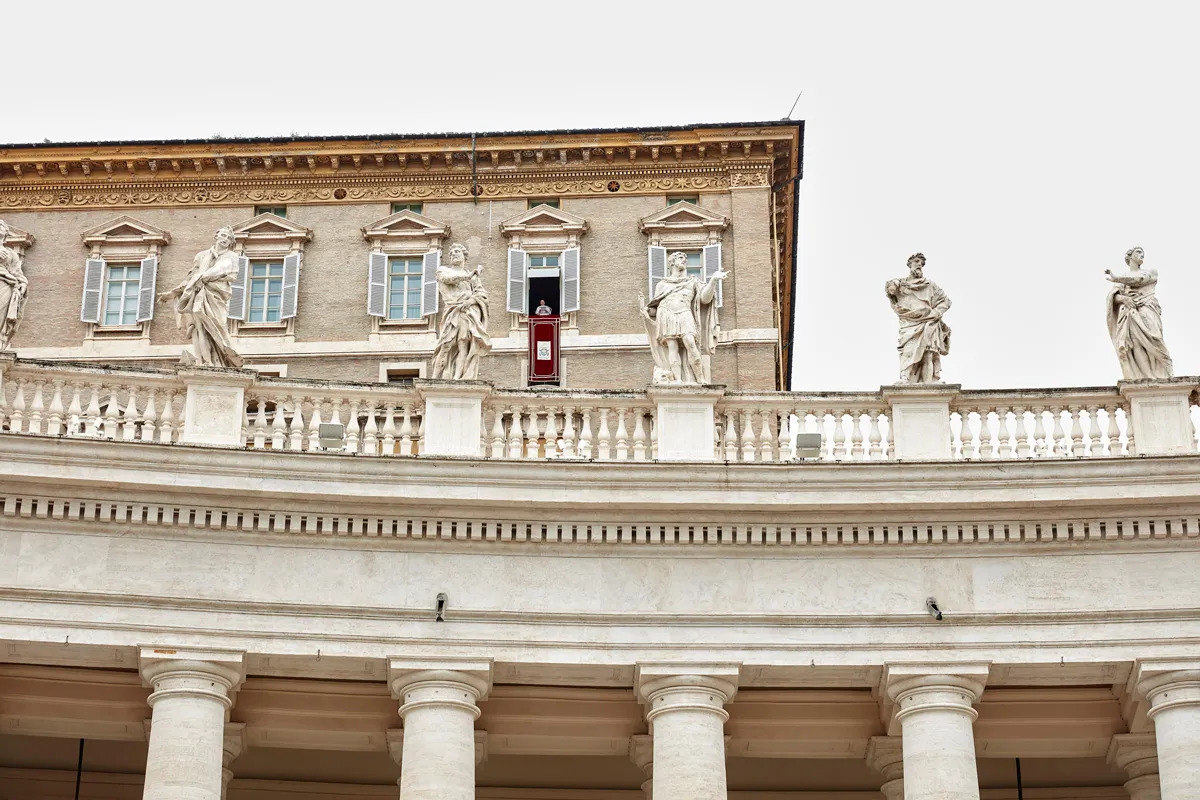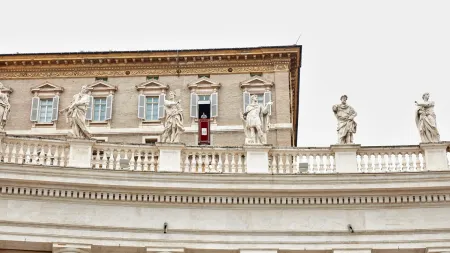
Has anyone other than photographer Catherine Opie ever stopped to consider how many windows there are at the Vatican? Probably not—and that’s something that got her thinking about the state of Catholic Church in the 21st century.
“When you go to the Vatican, the last thing you’re doing is looking out the window,” Opie told ARTnews. “There’s this irony, and a bit of humor. Beyond me are all these treasures, and meanwhile, I’m systematically photographing every single window.”
Over the course of six weeks during the summer of 2021, while she was an artist in residence at the American Academy in Rome, Opie visited the Vatican four days per week. Given the pandemic, the Vatican was largely empty of its usual swell of tourists. At first, she just wanted to take it all in—all the riches and centuries of history that she saw before her. Then she began to focus on the windows that face out toward Rome or into interior courtyards.
In doing so, she embarked on a grand inquiry: “Can we begin to really think about the horrific stories within the Catholic Church—what it has done to humanity, even though Christianity is for humanity?”
The results of Opie’s probe are now on view at Lehmann Maupin gallery in New York, where she is showing three recent bodies of work that deconstruct various parts of the Vatican—its windows, walls, and artistic treasures—in closely cropped photographs that home in the structures that undergird Catholicism and the brutal history that lies beneath it. Rather than presenting “a complete thesis about the Catholic Church in relationship to its history,” Opie said she thinks of this new body of work as taking something so iconic and allowing us to “begin to brush up against it” so we can examine at it anew.
The show opens with an image of Pope Francis’s balcony. Each Sunday, Opie would stand outside St. Peter’s Basilica, where she could see Francis giving his weekly address, the Angelus. At the time, Francis had acknowledged the Catholic Church’s role in the deaths of Indigenous children at Canadian residential schools who were found in mass graves, but he had yet to apologize.

Opie noticed that Francis stood before a window, and this aperture, for her, started to behave just like the Pope himself. “In today’s language, windows represent this notion of transparency—but are they transparent?” she said. “It’s trying to break down all of this hypocrisy.” Opie’s image carries a simple title: No Apology (June 5, 2021).
Given Opie’s work over the past four decades, which has highlighted facets of queerness, from leather subcultures to the tenderness of lesbian love and motherhood, this body of work might seem like an indictment of the Catholic Church. She said this wasn’t the case, however. “I’m not necessarily interested in burning down the Catholic Church,” Opie said. “I have this hope for this Pope, in a certain way. He’s trying to grapple with how the world has changed and how does he shift the church to be about humanity and humility versus the accumulation of the riches. I think it’s the one of the larger transformations in the history of the Catholic Church.”
But she was interested in dealing with critiquing power relationships. “We’re all really exploring that language right now,” she explained, “so it’s a quiet and a loud critique.”

Opie soon set out to zealously photograph every single window in the Vatican. It took about four days, and she came equipped with four cameras and her iPhone, at various times of day to capture them in different lights. The windows at the Vatican are equally varied: some have grids of iron bars in front them—they look impossible to open. Several are thrown ajar to let in a breeze. Still others are partially covered with scrims, diffusing the light they let in. Ones facing a brick wall are shown next to ones with beautiful vistas of the Vatican’s palatial grounds or the Eternal City beyond.
While the “Windows” series was not necessarily made as a response to the pandemic, that history is present here too. “During the pandemic, we were locked in, looking out windows,” Opie said. “What [does] looking out a window onto a city or a landscape mean, on multiple levels of where we are as human beings right now?”
In one of the “Windows” photographs, Opie’s reflection is barely discernible in a blue-tinted window. It’s a way to signal to the viewer that, in a way, she too is implicated in this work, in this history. But she’s not trying to queer the Vatican, she said. Rather, “it’s questioning the validity of this kind of doctrine”—one that does not allow gay people to marry in the Catholic Church and which recently called using surrogacy “deplorable”—“and who gets to be in and who gets to be out. That’s what windows do: they’re in and they’re out.”

Opie’s father raised her as an atheist, which was an unusual upbringing for a child in a small town in Ohio during the 1960s and ’70s. She attended Sunday school at an Episcopal Church before kindergarten—solely so she could be socialized with other kids, not to foster her spirituality. But more recently, Opie has developed a closer connection to Catholicism, as her former wife, Julie Burleigh, whom she was with for 21 years, was raised in a large Catholic family in Louisiana.
“I have always been interested in the intensity of the following of the Catholic Church, even before I was married to a Catholic,” she said, noting that she photographed John Paul II in his Popemobile during his 1987 visit to Los Angeles.
The “Windows” series, along with two others made at the Vatican, “Walls” and “Blood Grids,” is not transcendent, as Catholic art tends to be. But these series are still deeply engaged with the religion. Opie refers to the trio as her own “Holy Trinity.”

Like the “Windows,” the “Walls,” showing corners of the Vatican’s towering outdoor partitions, also deal directly with “the power of the church through its architecture,” she said. The Vatican itself is unique in that it is a city within a city, and its walls have long served as both borders and apparatuses of surveillance. Today, they are mounted with cameras that stand where members of the Swiss Guard likely once did; those cameras are visible in Opie’s pictures, where they appear quietly menacing.
The black-and-white “Walls” photographs are quite unlike any of Opie’s past works. They are extremely vertical, with each resting on two pink marble plinths, sourced from Naples and positioned to correspond to the walls that are pictured. Shot on film using a Hasselblad XPan camera, these grainy pictures are related to “the incredible way that we looked at a place like Rome through black and white images,” she said.
The “Blood Grids” are more oblique than the “Walls” and the “Windows.” Using a 600mm lens, she snapped close-ups of blood as seen in artworks at the Vatican. Many of those works show Christ’s Five Holy Wounds from the Crucifixion (the holes in his hands and feet, and where he was pierced on his side). Others show St. Sebastian’s torso being struck with arrows, horses being felled in battle, and Biblical beheadings. Often, the blood depicted is visceral: oozing from gashes or spurting out from the body. She then arranged these cropped images to create grids.

This subject matter is in some ways not new for Opie, whose iconic 1993 photograph Self-Portrait/Cutting shows her shirtless back with a childlike stick-figure drawing of two girls in front of a house carved into her skin. In that image, the blood still drips from several incisions.
“My body—my queer body—is not accepted, so I’m considered a pervert,” Opie said, reflecting on that image in the context of her Vatican series.
At the Vatican, she was reminded of the AIDS crisis—the number of friends and fellow artists she witnessed die and the heightened conservatism of the culture wars that saw politicians like Senator Jesse Helms condemn the photographs of Robert Mapplethorpe. “What blood meant for me, at the time that my friends were dying of AIDS, [was] that my blood was bad, but this blood is good,” she said, referring to the violent depictions of blood in the Vatican. “Whose blood is really acceptable?”
Opie didn’t expect to make works quite like this prior to coming to the Vatican, which she hadn’t visited previously. “I was so surprised at the amount of blood in the artwork. I knew it from churches and art history, but I didn’t understand that it was this pervasive representation throughout every segment [of it],” she said.

In paying attention to these instances of bloodshed, Opie also appreciated their depictions formally. “The paint of the blood becomes the abstract moment—you can just see the movement of the brush,” she said. “I’m thinking about how intensely the painters have to render, and then all of a sudden, they get to have this moment with blood.”
How Opie would display her photographs of painted bloodshed didn’t emerge until she was editing her selection down in the studio. “I ran out wall space,” she said. “I told my assistant, ‘Hang this in a grid.’ And then I realized the grid was doing this whole thing.”
Since Opie shot these images in the Vatican, the Catholic Church has itself changed, apologizing not just for the death of Indigenous children in residential schools but for its role in colonialism through papal decrees that instructed European powers to Christianize the world. “I love the idea that the timing of [showing] this body of work is also the timing of the Catholic Church talking about its own hypocrisies,” she said. “Maybe other people will begin to understand things within their own faith or within their own ideas of how they approach humanity.”
She continued, “I’ve always said that I can never change somebody’s opinion. If somebody’s a homophobe and they’re looking at my work, I know that I’m not going to make them not homophobic. But will I open up another way of entering these spaces through my formal attempt to begin to frame these ideas?” For Opie, that question is still open.
Lehmann Maupin, Kukje Gallery to Represent Octogenarian Korean Sculptor Kim Yun Shin
Top Museum Curators Are Joining Art Galleries. What’s Behind This Shift?

Million-Dollar Homes Are Becoming More Common in Small Towns Across the Country

Lightbox’s Advancements in Lab-grown Diamonds With Latest From The Future Rocks

PS5 March update includes AI-powered improvements for the DualSense controller

Adidas North America Revenue Falls 25% in Q4 Without Yeezy


